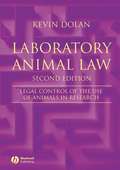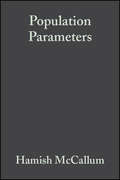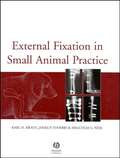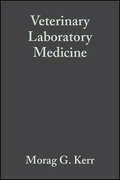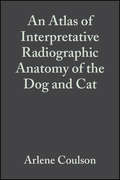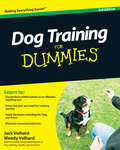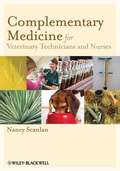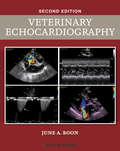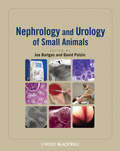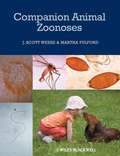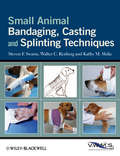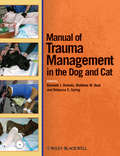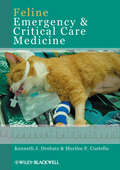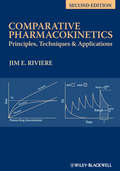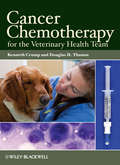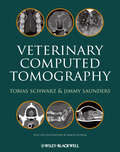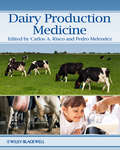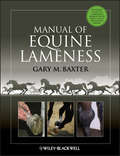- Table View
- List View
Laboratory Animal Law: Legal Control of the Use of Animals in Research
by Kevin DolanPraise for the first edition: “It is hard to see how anyone with responsibilities under the Animals (Scientific Procedures) Act could manage without a book such as this.” Michael Balls, review published in Atla “The strength of the book lies in the way Kevin Dolan brings his experience to bear blending information from various sources.” Patrick Sinnett-Smith, review published in RDS News Written by the leading expert in this field, this is the only book providing practical guidance on the legal obligations of caring for laboratory animals. Up-to-date information on all relevant UK legislation and guidelines is given, with the main emphasis being on the interpretation of the Animals (Scientific Procedures) Act 1986. New to this edition: *Emphasis throughout is now on the practical application of legal controls of the use of animals in research. *Updated where relevant to keep in line with new welfare legislation. *Coverage of current format of application for personal and project licences. *Expanded coverage of Certificates of Designation. *Impact of the Freedom of Information Act is discussed. A vital resource for all those involved with the use of animals in research, and especially those studying for qualifications or licences in this field.
Population Parameters: Estimation for Ecological Models (Ecological Methods and Concepts #3)
by Hamish McCallumEcologists and environmental managers rely on mathematical models, both to understand ecological systems and to predict future system behavior. In turn, models rely on appropriate estimates of their parameters. This book brings together a diverse and scattered literature, to provide clear guidance on how to estimate parameters for models of animal populations. It is not a recipe book of statistical procedures. Instead, it concentrates on how to select the best approach to parameter estimation for a particular problem, and how to ensure that the quality estimated is the appropriate one for the specific purpose of the modelling exercise. Commencing with a toolbox of useful generic approaches to parameter estimation, the book deals with methods for estimating parameters for single populations. These parameters include population size, birth and death rates, and the population growth rate. For such parameters, rigorous statistical theory has been developed, and software is readily available. The problem is to select the optimal sampling design and method of analysis. The second part of the book deals with parameters that describe spatial dynamics, and ecological interactions such as competition, predation and parasitism. Here the principle problems are designing appropriate experiments and ensuring that the quantities measured by the experiments are relevant to the ecological models in which they will be used. This book will be essential reading for ecological researchers, postgraduate students and environmental managers who need to address an ecological problem through a population model. It is accessible to anyone with an understanding of basic statistical methods and population ecology. Unique in concentrating on parameter estimation within modelling. Fills a glaring gap in the literature. Not too technical, so suitable for the statistically inept. Methods explained in algebra, but also in worked examples using commonly available computer packages (SAS, GLIM, and some more specialised packages where relvant). Some spreadsheet based examples also included.
External Fixation in Small Animal Practice
by Karl H. Kraus James P. Toombs Malcolm G. NessExternal fixation is one of the most versatile treatment options for fracture repair in small animals. The advantages include enhancing both the mechanical and biologic environment for optimal fracture healing. Veterinary external fixation is evolving and there are now improved techniques, better instrumentation and a continuing reduction in the incidence of complications. General veterinary practitioners can master the techniques and equipment costs are low. This book offers a highly practical guide to the use of linear external fixators in small animal practice. Divided into two sections, the first section reviews essential knowledge and technical details that underpin the successful treatment of a clinical case. The second is a collection of case studies selected to show the range of fracture types and fixator systems available. Within each case there is discussion of treatment options and clinical decision-making. Follow-up radiographs then provide invaluable insight into the normal radiographic appearance of healing and healed fractures. The authors have put together an intensely practical book that will no doubt prove to be the perfect learning tool for the surgical resident and practising veterinarian. Key features: A unique approach ensures the book is both practical and easy to read Written to appeal to practising veterinarians world-wide Contains over three hundred high quality radiographs Structured for detailed study or quick reference
Chemoecology of Insect Eggs and Egg Deposition
by Monika Hilker Torsten MeinersThis is the first book focusing on the chemoecology of insect eggs and egg deposition. It covers a wide range of different issues including herbivorous and carnivorous insects, social insects and those of medical and veterinary importance. The knowledge compiled in this book may promote future studies on evolutionary aspects on insect reproductive behaviour as well as on controlling insect pests by targeting the egg stage.
Veterinary Laboratory Medicine: Clinical Biochemistry and Haematology
by Morag G. KerrVeterinary Laboratory Medicine covers all aspects of basic clinical biochemistry and haematology, and includes test-by-test interpretation of laboratory results. Information is provided on sampling techniques, the selection and use of an external laboratory, as well as near-patient testing and the practice laboratory. Also included are step-by-step instructions for most commonly used point-of-care tests, a guide to the evaluation of instruments for in-practice use, and a detailed explanation of the principles of impedance counting and photometric analysis. The book will be ideal for practitioners who require a guide to laboratory work, and for veterinary students studying laboratory medicine and clinical pathology. The second edition has been fully updated to reflect advances in diagnostic techniques, and includes new chapters on diagnostic endocrinology and feline virus testing as well as a much expanded chapter on diagnostic profiling and pattern recognition.
An Atlas of Interpretative Radiographic Anatomy of the Dog and Cat
by Arlene Coulson Noreen LewisA good basic knowledge of radiological anatomy is essential for both the specialising and non-specialising veterinary audience. This comprehensive and general practice orientated reference book which provides detailed radiographic guidance on the normal clinical anatomy of the dog and cat. In addition to numerous projections of plain and contrast studies, this atlas includes detailed observations of the normal range of variations seen in the juvenile animal, differences between breeds and descriptions of the range of anatomical variations commonly encountered in veterinary practice. The clinical utility of the book has been greatly enhanced by the use of line drawings corresponding to the relevant radiographs and schematic drawings of those structures not normally visible in plain films. The authors, both with extensive teaching experience in postgraduate veterinary radiology, describe procedures and techniques routinely available in general veterinary practice. Monitored for anatomical accuracy throughout, this atlas provides a single volume reference for the general practitioner, undergraduate or postgraduate veterinary surgeon.
Dog Training For Dummies
by Jack Volhard Wendy VolhardMake training fun and effective This friendly guide shows you how to select the right training method for your dog, based on his unique personality, to reach your desired goals. Whether you want to teach Buddy to sit or master retrieving, you'll get expert training tips and techniques for you and your dog — to ensure a mutually respectful relationship with your four-legged friend. Concentrate on canines — discover why your dog acts the way she does, understand her nutritional needs, and ready yourself for the task of training your dog Prep for your pup — prepare your home for your puppy's arrival, discover the importance of socialization, and get started on housetraining Put your best paw forward — teach basic commands like Sit, Stay, and Down, and get the scoop on how to deal with doggie don'ts like chewing, digging, and excessive barking Take training to the next level — get involved in organized dog activities and competitions, where you'll both show off impressive tricks like retrieving, figure 8s, and much more Open the book and find: Step-by-step instructions for teaching your dog basic commands Helpful advice on crate training Safe ways to address aggression and separation anxiety Tips for teaching Buddy to behave himself around people and other dogs Techniques to keep your senior dog feeling young Health issues that can interfere with training Experts to turn to for training help Learn to: Use positive reinforcement as an effective teaching tool Select the gear you need for training success Teach the basics including Sit, Stay, and Down Eliminate unwanted behavior
Complementary Medicine for Veterinary Technicians and Nurses
by Nancy ScanlanComplementary Medicine for Veterinary Technicians and Nurses is the first resource on holistic veterinary care written specifically for the veterinary technician. Organized by treatment modality, the book offers practical information designed to help readers develop an understanding of each modality, assist with procedures associated with holistic medicine, and knowledgeably discuss treatment options with clients. Outlining the respective roles of technicians and veterinarians throughout, this book is a welcome reference for readers looking to expand their knowledge of complementary veterinary medicine and introduce additional treatment options in their practice.
Veterinary Echocardiography
by June A. BoonVeterinary Echocardiography, Second Edition is a fully revised version of the classic reference for ultrasound of the heart, covering two-dimensional, M-mode, and Doppler examinations for both small and large animal domestic species. Written by a leading authority in veterinary echocardiography, the book offers detailed guidelines for obtaining and interpreting diagnostic echocardiograms in domestic species. Now thoroughly updated to address advances in technology, including better transducers, tissue harmonic imaging, better color flow mapping, and color and spectral tissue Doppler imaging, this second edition provides an authoritative, comprehensive resource for echocardiographers of all levels of experience. The Second Edition has been restructured to be more user-friendly, with chapters on acquired and congenital heart diseases broken down into shorter disease-specific chapters. Key changes include the addition of normal tissue Doppler technique, as well as five new appendices, covering topics such as normal reference ranges and an exam checklist. Veterinary Echocardiography, Second Edition builds on the success of the previous edition to provide complete information on obtaining echocardiograms in veterinary medicine.
Nephrology and Urology of Small Animals
by Joseph Bartges David PolzinNephrology and Urology of Small Animals provides veterinarians with the knowledge needed to effectively diagnose and treat urologic diseases in canine, feline, and exotic patients. Serving as an easy-to-use, comprehensive clinical reference, the text takes an evidence-based approach to detailed coverage of specific diseases and disorders, including etiology and prevalence, clinical signs, diagnosis, treatment, prevention, prognosis, controversies, and references. Coverage also includes practical review of anatomy and physiology of the urinary system, fundamentals of diagnostic testing and therapeutic techniques.
Complementary Medicine for Veterinary Technicians and Nurses
by Nancy ScanlanComplementary Medicine for Veterinary Technicians and Nurses is the first resource on holistic veterinary care written specifically for the veterinary technician. Organized by treatment modality, the book offers practical information designed to help readers develop an understanding of each modality, assist with procedures associated with holistic medicine, and knowledgeably discuss treatment options with clients. Outlining the respective roles of technicians and veterinarians throughout, this book is a welcome reference for readers looking to expand their knowledge of complementary veterinary medicine and introduce additional treatment options in their practice.
Companion Animal Zoonoses
by J. Scott Weese Martha FulfordCompanion Animal Zoonoses is a comprehensive resource on diseases transmissible between animals and humans. Presenting detailed prevention and control strategies for zoonotic diseases, the book is an in-depth guide to practical information on the spread of disease between pet animals and humans. This relevant work provides up-to-date information on emerging issues, disease incidence and risk, and management measures. Covering the complete range of companion animal zoonoses, each topic begins with information on etiology, geographic distribution, epidemiology, and pathophysiology. The discussion then moves into clinical presentation, diagnosis, and management, alongside prevention information for both animals and humans. Companion Animal Zoonoses is an essential reference for practicing veterinarians, public health veterinarians, and veterinary students. It will also appeal to physicians who wish to better understand zoonotic diseases.
Veterinary Echocardiography
by June A. BoonVeterinary Echocardiography, Second Edition is a fully revised version of the classic reference for ultrasound of the heart, covering two-dimensional, M-mode, and Doppler examinations for both small and large animal domestic species. Written by a leading authority in veterinary echocardiography, the book offers detailed guidelines for obtaining and interpreting diagnostic echocardiograms in domestic species. Now thoroughly updated to address advances in technology, including better transducers, tissue harmonic imaging, better color flow mapping, and color and spectral tissue Doppler imaging, this second edition provides an authoritative, comprehensive resource for echocardiographers of all levels of experience. The Second Edition has been restructured to be more user-friendly, with chapters on acquired and congenital heart diseases broken down into shorter disease-specific chapters. Key changes include the addition of normal tissue Doppler technique, as well as five new appendices, covering topics such as normal reference ranges and an exam checklist. Veterinary Echocardiography, Second Edition builds on the success of the previous edition to provide complete information on obtaining echocardiograms in veterinary medicine.
Small Animal Bandaging, Casting, and Splinting Techniques
by Steven F. Swaim Walter C. Renberg Kathy M. ShikeSmall Animal Bandaging, Casting, and Splinting Techniques is a well-illustrated how-to manual covering common bandaging methods used to support and manage both soft tissue and orthopedic conditions in small animal patients. This highly practical book offers step-by-step procedures with accompanying photographs to aid in the secure and effective application of bandages, casts, and splints, with coverage encompassing indications, aftercare, advantages, and potential complications for each technique. Small Animal Bandaging, Casting, and Splinting Techniques is an indispensable guide for busy veterinary technicians and nurses, as well as veterinarians and veterinary students.
Small Animal Bandaging, Casting, and Splinting Techniques
by Steven F. Swaim Walter C. Renberg Kathy M. ShikeSmall Animal Bandaging, Casting, and Splinting Techniques is a well-illustrated how-to manual covering common bandaging methods used to support and manage both soft tissue and orthopedic conditions in small animal patients. This highly practical book offers step-by-step procedures with accompanying photographs to aid in the secure and effective application of bandages, casts, and splints, with coverage encompassing indications, aftercare, advantages, and potential complications for each technique. Small Animal Bandaging, Casting, and Splinting Techniques is an indispensable guide for busy veterinary technicians and nurses, as well as veterinarians and veterinary students.
Manual of Trauma Management in the Dog and Cat
by Kenneth J. Drobatz Matthew W. Beal Rebecca S. SyringManual of Trauma Management in the Dog and Cat provides quick access to clinically relevant information on stabilizing, diagnosing, and managing the trauma patient. The book uses an outline format to provide fast access to essential information, focusing on practical advice and techniques for treating traumatic injuries. Manual of Trauma Management in the Dog and Cat is an ideal handbook for quickly and confidently managing this common presenting complaint. Beginning with a concise summary of the global assessment of traumatized patients, the heart of the book is devoted to guidance on managing specific types of trauma following definitive diagnosis. Manual of Trauma Management in the Dog and Cat is a valuable quick-reference guide to treating canine and feline trauma patients for general practitioners and emergency specialists alike.
Feline Emergency and Critical Care Medicine (Coursesmart Ser.)
by Kenneth J. Drobatz Merilee CostelloFeline Emergency and Critical Care Medicine is the first book to focus specifically on feline-specific emergency and critical care. Designed as a quick-access manual of emergency and critical care procedures, information is presented in an easy-to-follow outline format. With an emphasis on the unique considerations for treating cats, this book provides all the information needed to confidently manage the feline critical patient.
Comparative Pharmacokinetics: Principles, Techniques and Applications
by Jim E. RiviereNow in a revised edition, Comparative Pharmacokinetics: Principles, Techniques, and Applications presents the principles and techniques of comparative and veterinary pharmacokinetics in a detailed yet practical manner. Developed as a tool for ensuring that pharmacokinetics studies are properly designed and correctly interpreted, the book provides complete coverage of the conceptual basis of pharmacokinetics as used for quantifying biological processes from the perspectives of physiology and medicine. New chapters have been added on quantitative structure permeability relationships and bioequivalence, and a number of existing chapters have been significantly revised and expanded to provide a current resource for veterinary and comparative pharmacokinetics.
Cancer Chemotherapy for the Veterinary Health Team
by Kenneth Crump Douglas H. ThammCancer Chemotherapy for the Veterinary Health Team is a clinically relevant and practical manual designed as a guide for the safe and effective administration of cancer chemotherapy. Coverage includes patient assessment, chemotherapy equipment, drug preparation, safety considerations, handling, administration, waste disposal, and management of chemotherapy side effects. An alphabetical listing of common chemotherapy agents offers information on their uses, indications, and toxicities, as well as administration guidelines for methods, routes, and speeds. With background information for effectively communicating with clients, including coverage of veterinary cancer surgery and radiation therapy, the book provides specific strategies that address the challenging emotional issues surrounding the diagnosis and treatment of cancer in pets. With particular insight into the technician's role, Cancer Chemotherapy for the Veterinary Health Team is a must-have reference for any practice offering chemotherapy.
Cancer Chemotherapy for the Veterinary Health Team
by Douglas H. ThammCancer Chemotherapy for the Veterinary Health Team is a clinically relevant and practical manual designed as a guide for the safe and effective administration of cancer chemotherapy. Coverage includes patient assessment, chemotherapy equipment, drug preparation, safety considerations, handling, administration, waste disposal, and management of chemotherapy side effects. An alphabetical listing of common chemotherapy agents offers information on their uses, indications, and toxicities, as well as administration guidelines for methods, routes, and speeds. With background information for effectively communicating with clients, including coverage of veterinary cancer surgery and radiation therapy, the book provides specific strategies that address the challenging emotional issues surrounding the diagnosis and treatment of cancer in pets. With particular insight into the technician's role, Cancer Chemotherapy for the Veterinary Health Team is a must-have reference for any practice offering chemotherapy.
Veterinary Computed Tomography
by Tobias Schwarz Jimmy SaundersThis practical and highly illustrated guide is an essential resource for veterinarians seeking to improve their understanding and use of computed tomography (CT) in practice. It provides a thorough grounding in CT technology, describing the underlying physical principles as well as the different types of scanners. The book also includes principles of CT examination such as guidance on positioning and how to achieve a good image quality. Written by specialists from twelve countries, this book offers a broad range of expertise in veterinary computed tomography, and is the first book to describe the technology, methodology, interpretation principles and CT features of different diseases for most species treated in veterinary practice. Key features • An essential guide for veterinarians using CT in practice • Includes basic principles of CT as well as guidelines on how to carry out an effective examination • Describes CT features of different diseases for most species treated in practice • Written by a range of international leaders in the field • Illustrated with high quality photographs and diagrams throughout
Dairy Production Medicine
by Carlos Risco Pedro MelendezThis comprehensive book integrates new technology and concepts that have been developed in recent years to manage dairy farms in a profitable manner. The approach to the production of livestock and quality milk is multidisciplinary, involving nutrition, reproduction, clinical medicine, genetics, pathology, epidemiology, human resource management and economics. The book is structured by the production cycle of the dairy cow covering critical points in cow management. Written and edited by highly respected experts, this book provides a thoroughly modern and up-to-date resource for all those involved in the dairy industry.
Dairy Production Medicine
by Carlos A. Risco Pedro Melendez RetamalThis comprehensive book integrates new technology and concepts that have been developed in recent years to manage dairy farms in a profitable manner. The approach to the production of livestock and quality milk is multidisciplinary, involving nutrition, reproduction, clinical medicine, genetics, pathology, epidemiology, human resource management and economics. The book is structured by the production cycle of the dairy cow covering critical points in cow management. Written and edited by highly respected experts, this book provides a thoroughly modern and up-to-date resource for all those involved in the dairy industry.
Manual of Equine Lameness
by Gary M. BaxterManual of Equine Lameness provides essential information on equine lameness diagnostics and treatment in an easy-to-use format ideal for the clinical setting. A clinically relevant distillation of topics from Adams and Stashak's Lameness in Horses, this text offers a quick introduction and fast access to key information. An accompanying DVD includes practical supplements, including additional anatomical images, video clips demonstrating key procedures such as perineural and intrasynovial injections, and examples of lameness conditions in motion. Designed for use in daily practice, the book is presented in brief chapters carefully formatted to maximize the usefulness for practicing veterinarians. Manual of Equine Lameness is an invaluable resource to any veterinarian treating lameness in horses and an ideal reference for veterinary students wanting to learn the fundamentals of lameness.
Manual of Equine Lameness
by Gary M. BaxterManual of Equine Lameness provides essential information on equine lameness diagnostics and treatment in an easy-to-use format ideal for the clinical setting. A clinically relevant distillation of topics from Adams and Stashak's Lameness in Horses, this text offers a quick introduction and fast access to key information. An accompanying DVD includes practical supplements, including additional anatomical images, video clips demonstrating key procedures such as perineural and intrasynovial injections, and examples of lameness conditions in motion. Designed for use in daily practice, the book is presented in brief chapters carefully formatted to maximize the usefulness for practicing veterinarians. Manual of Equine Lameness is an invaluable resource to any veterinarian treating lameness in horses and an ideal reference for veterinary students wanting to learn the fundamentals of lameness.
